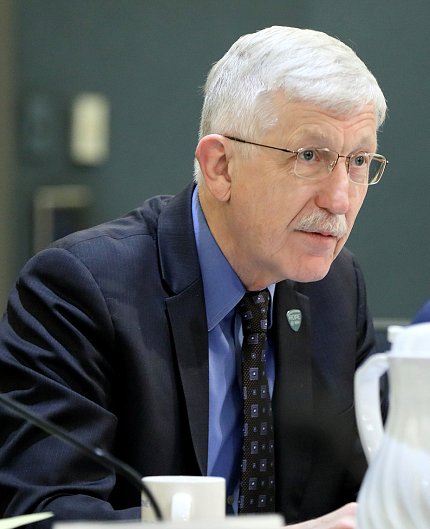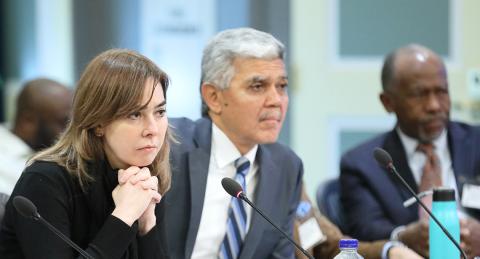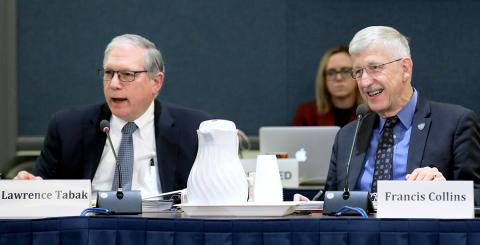Bold Recommendations Address People, Policy
ACD Aims to Change Research Culture, Inside and Out

Photo: Chia-Chi Charlie Chang
If the convening of the 119th advisory committee to the NIH director (ACD) forecast the direction the agency is headed, then NIH is truly moving boldly into the future. Considering a host of issues from A—artificial intelligence, to Z—zoology (well, research using animals), NIH is determined to identify and support not only the brightest scientific minds, but also the most ethical medical science in the world. And NIH is determined to address anything—including workplace bias, harassment or foreign influence—that might present a barrier to those goals.
As usual, NIH’s biannual meeting with its most august set of advisors packed the day and a half with both the stimulating and the sticky. How can NIH ensure its IT infrastructure is robust enough to keep pace with exponential data growth and the impact of AI? How do NIH researchers collaborate with scientists from other countries without compromising domestic resources?
“When you think about the number of topics that we’ve asked [the ACD] to wrestle with, it’s breathtaking,” NIH director Dr. Francis Collins told his advisors. “We range [across] deep questions about science—the ACD having been the author of the BRAIN Initiative, of Precision Medicine and All of Us, and now a whole new plan in artificial intelligence. But then on top of that, we hand you really hard questions about our workforce in terms of diversity, how to be sure we’re supporting the next generation of researchers in the best possible way…and then some really thorny policy issues like conversations on sexual harassment. And you seem really capable of wrapping your arms around all of those things and always providing just the right kind of insight we need.”
In his director’s report, Collins summarized the previous 6 months worth of research advances, VIP visits to NIH and senior staff changes, including a new chief executive officer for All of Us, Dr. Joshua Denny (see story).
Leading the first day’s docket was an interim report from the ACD working group established in June 2019 to look at ways to enhance rigor and reproducibility in animal research. NIH principal deputy director Dr. Lawrence Tabak, who cochairs the group, presented.
“Often animal studies serve as a foundation for human clinical trials, so there is an inherent cost when reproducibility and/or translatability fail,” he said, framing the group’s charge to identify areas where research rigor could be strengthened.
A Focus on Institutions
NIH chief officer for scientific workforce diversity Dr. Hannah Valantine, who co-chairs the ACD working group on diversity, gave a 3-part update—implementing 2018 recommendations, highlighting the NIH Distinguished Scholars Program and outlining 2019 recommendations from June’s NIH Advancing Diversity Programs Conference (ADPC).
“We’d all realized that prior efforts had been focused on the individual,” Valantine said. “And while those were important—especially for building the pipeline—and need to continue, they are necessary but not sufficient. The time has come to focus on the institution—creating institutional culture change.”

Photo: Chia-Chi Charlie Chang
Making diversity/inclusion strategies integral components of senior-level performance plans, rewarding innovators in those areas and developing metrics and templates were among ideas that saw significant progress since 2018, she said.
The ADPC recommended replicating and sharing programs that have strong evidence of effectiveness and looking into grant applications/renewals as ways to incentivize institutional culture change.
NIH deputy director for extramural research Dr. Michael Lauer presented updates on the Next Generation Researchers Initiative.
He talked about added flexibility for individuals applying for support as early-stage investigators (ESIs). The current definition is 10 years past terminal research degree or from completion of clinical training; recently childbirth—the reason most applicants cite when asking for more time—was added as an automatic 1-year extension.
Lauer also described a new kind of RO1 award, named in honor of the late NIAMS director Dr. Stephen Katz, to encourage ESIs to pursue entirely new research directions. Applications for the 5-year funding specifically disallow preliminary data.
In fiscal year 2018, NIH for the first time met its goal of funding at least 1,100 ESIs, with more than 1,280 ES grantees, said Lauer. More than 1,300 ESIs were funded in FY19.
Workplace Climate Conditions
Leading what could potentially set the stage for significant shifts in workplace conditions of research enterprises nationwide, NIH conducted a Workplace Climate and Harassment Survey of its own staff early in 2019. The survey aimed to assess the environment for employees and provide evidence-based data for NIH leadership as well as the ACD working group charged with exploring the issue.
The goals were to measure harassment prevalence at NIH, get a snapshot of the workplace climate, determine its impact on mental and physical health and gain perspectives on reporting harassment. Valantine reported findings from the survey, which asked about all kinds of discriminatory behavior, including unwanted sexual attention, gender harassment and sexual coercion.
Among key findings were:
- 1 in 5 respondents had experienced at least 1 incident of sexual harassment in the past 12 months
- Women who are trainees (fellows and students), younger individuals, sexual and gender minorities and individuals with disabilities are the most vulnerable populations experiencing the highest incidence of sexual harassment
- More than half of respondents who experienced harassment did not talk to anyone about it
- Respondents who felt their supervisors were not supportive were more likely to experience harassment and workers who were being bullied were also more likely to experience gender and sexual harassment.
Next steps include release of an executive summary early in 2020, sharing the data with the NIH workforce, deeper analysis of the data and implementation of action plans for key findings.
Collins said he hoped ACD members and other colleagues in science and research would consider adapting the survey instrument for their own institutions, so that NIH could have comparative data about similar organizations. NIH will be releasing the survey, together with a user manual, early in the new year.
Internally, NIH has instituted a broad range of resources to prevent and redress harassment of all types. In 2018, NIH reviewed 232 intramural allegations of harassment; 43 of those were sexual. In 2019 (through November), NIH reviewed 271 allegations; 68 were sexual. NIH has also moved forward to make it possible for individuals at grantee institutions to contact NIH directly about harassment. Externally, in 2018, NIH reviewed 28 incidents; in 2019, 105 inquiries were reviewed at more than 50 institutions.
Report Presented on Changing Culture
The first day’s deliberations ended with the final report of the working group on changing culture to end harassment, presented by the group’s three co-chairs—ACD members Dr. Francis Cuss (ret.) of Bristol-Myers Squibb and Dr. Kristina Johnson of State University of New York and NIH associate director for science policy and acting chief of staff Dr. Carrie Wolinetz.
Four key themes from the report include:
- Increase transparency and accountability in reporting of professional misconduct, especially sexual harassment
- Establish mechanisms for restorative justice
- Ensure safe, diverse and inclusive research and training environments
- Create system-wide change to ensure that the above occurs.
NIH will continue working with stakeholders to develop best practices for establishing safe, diverse and inclusive research environments. Notably, Wolinetz also co-chairs the subcommittee on safe and inclusive research environments (SIRE) of the National Science and Technology Council’s joint committee on research environments. SIRE has representation from several federal departments and agencies and builds on interagency or agency-specific efforts. One committee goal is to coordinate and facilitate sharing of best practices.
“Implementing this much-needed cultural change requires essentially a partnership between NIH, the NIH-funded institutions and other scientific societies,” said Cuss. He also noted that his working group felt “an enormous sense of urgency” to provide immediately actionable recommendations.
The report provided detailed recommendations to address each key theme.
For example, to increase transparency and accountability, the report recommended eight measures, including that NIH should:
- Create a parallel process to treat professional misconduct, including sexual harassment, as seriously as research misconduct
- Establish a hotline and web-based form for reporting sexual harassment and inappropriate behavior by any principal investigator or key personnel funded by NIH
- Establish clear and transparent standard operating procedures to respond to reports or findings of professional misconduct, including sexual harassment, or change in PI status in extramurally funded laboratories.
Vigorous discussion ensued. Ultimately the ACD voted to support the recommendations, recognizing that a few of them may require additional legal authorities. NIH will continue to institute the kind of policies and cultural changes advocated by the working group.
“Science thrives in safe, diverse and inclusive research environments,” Collins said, in a statement following release of the report to the public, “and sexual harassment goes against the very core of what NIH and the institutions we fund represent. Ensuring a culture where we are maximizing talent at all levels is at the heart of the NIH mission to improve human lives. This report lays out a framework to make that culture a reality.”
Collins’s full statement and a summary of the group’s work are posted online at https://go.usa.gov/xda3h.
Sharing, Protecting Resources
On day 2, the group took on 4 topics, 2 involving information technology.

Photo: Chia-Chi Charlie Chang
Data science associate director Dr. Susan Gregurick talked about the current state of NIH’s IT ecosystem and bold plans for expansion, including leveraging the cloud for biomedical research.
The STRIDES (Science and Technology Research Infrastructure for Discovery, Experimentation and Sustainability) Initiative is enabling NIH enterprise-wide access to the cloud.
“Harmonizing data still presents a challenge and is still a very active area of research,” Gregurick said.
Continuing the tech theme, Verily engineering director and ACD member David Glazer gave the final report from the working group on artificial intelligence.
“What can NIH do to maximize the opportunity for AI to make a difference in biomedicine?” he asked, reiterating his group’s initial charge.
“We have these two parallel revolutions—generating data and analyzing data,” Glazer explained. “We want to have these things not only working side by side, but also informing and changing each other.” The term “ML-BioMed,” he said, has been coined as a way to discuss “fusing the biomedicine and machine learning revolutions.”
Later in the morning, Lauer returned to discuss the latest on foreign influence on research integrity.
“It’s important to keep in mind that we routinely collaborate productively with investigators in foreign countries,” he noted. “We rely on productive research collaborations. The individuals we have identified as violating the laws and policies represent a small proportion of scientists working in and with U.S. institutions. We must not reject brilliant minds working honestly and collaboratively to provide hope and healing.”
Lauer recalled the specific infractions that raised red flags in August 2018: failure of visiting scientists to disclose substantial foreign resources and financial conflicts of interest, potential diversion of intellectual property and peer review violations.
“It’s getting worse,” he reported. “We are seeing more, and some of the types of problems we are seeing are even more severe…In nearly all these cases, American institutions are unaware—or have a misleading impression of what [is going on].”
The last topic of the session addressed formulation of an NIH-wide Strategic Plan for 2021-2025. NIH deputy director for program coordination, planning and strategic initiatives Dr. James Anderson outlined rules of engagement for developing the new plan, which will lay out NIH objectives and priorities for the next 5 or 6 years.
“The new plan will represent an update of the first plan,” he explained, “but will not be a complete overhaul.”
At the NIH director’s behest, the new vision will also include several bold predictions, as did the first plan.
“Even though we may put forward some things that will fail to hit,” Collins concluded, “I like the idea of putting out some really bold ideas so that people might go, ‘Wow, you might be able to do that?’…Even with the risks of not achieving the goals, I think it’s worth it to cast a bold vision.”
Meeting materials are available at https://acd.od.nih.gov/meetings.html. To view archived ACD proceedings online, visit https://go.usa.gov/xdcCq for day 1 and https://go.usa.gov/xdcCc for day 2.
